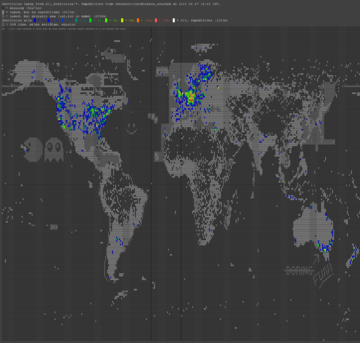Difference between revisions of "Maps and statistics"
imported>Dawidi (now using the "new" All_Graticules/* pages, also minor other updates) |
imported>Relet (→World map of All Graticules) |
||
| Line 12: | Line 12: | ||
(Notice the graticules have links and title texts.) | (Notice the graticules have links and title texts.) | ||
| + | |||
| + | == [http://relet.net/geco/stats.html Interactive Map of All Expeditions] == | ||
| + | Shows a slippy map with all graticules that have expedition reports. The colour scheme represents number of attempted expeditions. | ||
| + | |||
| + | Clicking on a graticule reveals some statistics about the graticule, and displays markers for all expeditions in this graticule. | ||
== [http://home.widicam.net/geohashing/ExpeditionGraticules/ World map of Successful Expeditions] == | == [http://home.widicam.net/geohashing/ExpeditionGraticules/ World map of Successful Expeditions] == | ||
Revision as of 17:55, 25 March 2012
User:dawidi has written a geohashing statistics generator. It reads some wiki pages, and currently outputs a few static html pages. Thanks to the folks on #geohashing for their positive feedback and constructive criticism :)
More features are in the making, and I'm always open for suggestions.
If you're curious, the program is written in C#/.NET 2.0 without any extra libraries. For the moment, it's a scheduled task on my server, updating the statistics once a day, at 10:45 CET (9:45 UTC).
Contents
World map of All Graticules
Shows which graticules have been named, and which have their own wiki pages.
Graticule names and positions are read from the world region pages at Category:All graticules. A graticule that doesn't have a page is considered to be sea and colored blue if it has its own lat, lon in the name.
(Notice the graticules have links and title texts.)
Interactive Map of All Expeditions
Shows a slippy map with all graticules that have expedition reports. The colour scheme represents number of attempted expeditions.
Clicking on a graticule reveals some statistics about the graticule, and displays markers for all expeditions in this graticule.
World map of Successful Expeditions
Shows graticules colored by number of documented successful hash visits (from Category:Coordinates_reached). The color gradient used is nonlinear, so differences between graticules with few visits are easier to see. Unsuccessful expeditions are not counted, as those categories seem to include a lot of planned expeditions that did not take place after all.
Also includes the named and named/sea graticules from the world region pages at Category:All graticules in a brighter gray.
(Notice the graticules have links and title texts.)
Global Activity by week
Shows bar graphs of the number of successful visits per week, both for the entire globe and for each continent.
The continent "outlines" are, for the moment, simply 6 rectangular blocks of graticules covering the entire globe (see bottom of the page for the exact sizes), so the breakdown may not be useful for e.g. Antarctica, and may assign some obscure regions to the wrong continent. The edges were chosen such that all 2008 expeditions are counted for the correct continent. The 2009 expeditions in Israel are currently counted for Africa, but I'm too lazy to refine the region borders at the moment.
(I know it lacks a scale, but look at the title texts for numbers.)
"Global village" graticule
Generated from a user-contributed list at Maps and Statistics/User Fractions, it's a rendering of geohasher locations around the world, but mapped onto one square graticule, so people who live in the same corner of their respective graticules, but in an entirely different graticule, will end up close to each other. I suppose distances on that map will indicate how likely it is for people to do expeditions (to hashes near their homes) on the same day, not how likely they are to meet.
Yes, it's difficult to explain and a ridiculous concept... the idea arose from regularly attending the zbot summoning ceremony in #geohashing, after which we usually start voicing our opinions about the new coordinates and wildly disagreeing about whether they are "good" or "bad", depending on where each of us lives relative to the grid :-)
Geohasher age/sex demographics
An age-sex pyramid graph showing the distribution of age groups among geohashers (at least those using valid ASG templates). Since updating this graph requires the script to download and parse all users' pages, I don't plan to include this in the daily update to avoid stressing the wiki server unnecessarily; it may get a weekly or monthly update.
After complaints that the categorising of hashers into m and f was too restrictive, the script now accepts ASGs with other values for the gender parameter as well and lists them as "other". I hadn't really expected that to be necessary...
Also, people who give their age as negative (or their birthday as a date in the future) or who are over a hundred years old will be listed under "invalid age", independent of gender. (May be changed if time travel is implemented or the Old Geohash record reaches 90.)
Most active graticules
A table showing the 15 most active graticules (highest number of expeditions from Category:Coordinates_reached and Category:Coordinates_not_reached) for each month, year and overall. If there are graticules with equal activity, they are ordered by latitude and longitude.
Most successful graticules
Similar to the above, but only counts successful expeditions from Category:Coordinates_reached.
